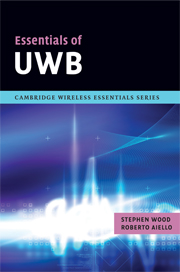Book contents
- Frontmatter
- Contents
- 1 Introducing ultra-wideband (UWB)
- 2 Matching UWB to HDR applications
- 3 Physical-layer (PHY) characteristics
- 4 Media-access control (MAC) layer
- 5 Implementation information
- 6 Upper-layer protocols
- 7 Ultra-wideband standardization
- 8 Special-interest groups
- 9 Ultra-wideband business issues
- 10 Regulating ultra-wideband
- 11 Tragedy of the commons
- Appendix: Reference documents
- Author biographies
- Index
- References
3 - Physical-layer (PHY) characteristics
Published online by Cambridge University Press: 22 August 2009
- Frontmatter
- Contents
- 1 Introducing ultra-wideband (UWB)
- 2 Matching UWB to HDR applications
- 3 Physical-layer (PHY) characteristics
- 4 Media-access control (MAC) layer
- 5 Implementation information
- 6 Upper-layer protocols
- 7 Ultra-wideband standardization
- 8 Special-interest groups
- 9 Ultra-wideband business issues
- 10 Regulating ultra-wideband
- 11 Tragedy of the commons
- Appendix: Reference documents
- Author biographies
- Index
- References
Summary
The high-data-rate UWB products in development and shipping today are based on what is known as the WiMedia common radio platform (Figure 3.1). This chapter will provide a somewhat abbreviated technical overview of the physical layer, which makes up the lowest portion of the radio design. The intention here is to hit the highlights. For the reader who needs to understand the nuts and bolts of the radio's design, the ECMA-368 standards is recommended.[1] The content will focus on some of the more interesting facets of the design, which may be needed by individuals desiring a system view of the radio.
At the base of the common radio platform (Figure 3.2) lays the physical layer (PHY). Originally coined as a networking term, PHY refers to the combination of software and hardware programming that defines the electrical, mechanical and functional specifications to activate, maintain, and deactivate the transmission interfaces (or links) between communicating systems. The PHY may or may not include electromechanical devices, but in essence, it is the brains of the radio. Basically, the PHY's job is to transmit bits of data over a communication medium in either digital or analogue form. It makes no difference as to what those bits represent; the PHY operates in the same way regardless of the type of data. Physical-layer specifications typically define characteristics such as voltage levels, the timing of voltage changes, data rates, maximum transmission distances and physical connectors.
- Type
- Chapter
- Information
- Essentials of UWB , pp. 37 - 47Publisher: Cambridge University PressPrint publication year: 2008



